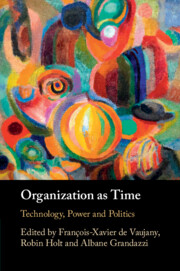Book contents
- Organization as Time
- Organization as Time
- Copyright page
- Contents
- Figures
- Tables
- Contributors
- Organization as Time
- Part I The Politics of Time: Ontologies and Metaphysics of Organization as Time
- 1 Media Temporalities and the Technical Image
- 2 Material Temporal Work in Artistic Innovation
- 3 In the Practice Agencement
- 4 Metaphysics of Tragedy, a Non-Dispositional View of Time
- Part II Re-orienting Critique in Organization Studies? Exploring Jointly Time and Politics
- Part III New Ways of Organizing Work, Digitality and the Politics of Time
- Part IV History and Duration: Making Things Last, Enduring Politics and Organizing
- Index
- References
3 - In the Practice Agencement
Rhythms, Refrains and Feminist Snaps
from Part I - The Politics of Time: Ontologies and Metaphysics of Organization as Time
Published online by Cambridge University Press: 22 June 2023
- Organization as Time
- Organization as Time
- Copyright page
- Contents
- Figures
- Tables
- Contributors
- Organization as Time
- Part I The Politics of Time: Ontologies and Metaphysics of Organization as Time
- 1 Media Temporalities and the Technical Image
- 2 Material Temporal Work in Artistic Innovation
- 3 In the Practice Agencement
- 4 Metaphysics of Tragedy, a Non-Dispositional View of Time
- Part II Re-orienting Critique in Organization Studies? Exploring Jointly Time and Politics
- Part III New Ways of Organizing Work, Digitality and the Politics of Time
- Part IV History and Duration: Making Things Last, Enduring Politics and Organizing
- Index
- References
Summary
The chapter assumes a feminist new materialist approach to explore the entanglement of temporality, materiality and power within a practice agencement. Feminist new materialism in empirical research is a methodology that emphasizes the vitality of matter and the performative and affective flow of agency. The chapter deals both with the materiality of human bodies (and normative embodiment in organizations) and with the materiality of digital technologies and their normative power over teens’ sexuality. Temporality is explored by means of two concepts – refrain and feminist snap – that create orientations for thinking about how the entangled elements that form a practice assume in time different configurations according to the elements’ capacity to affect and be affected. While refrain illuminates the lines of flight within differentiating practices, feminist snap highlights the breaking moment of discontinuity when digital networking subverts the control on women’s bodies.
- Type
- Chapter
- Information
- Organization as TimeTechnology, Power and Politics, pp. 61 - 82Publisher: Cambridge University PressPrint publication year: 2023
References
- 2
- Cited by

